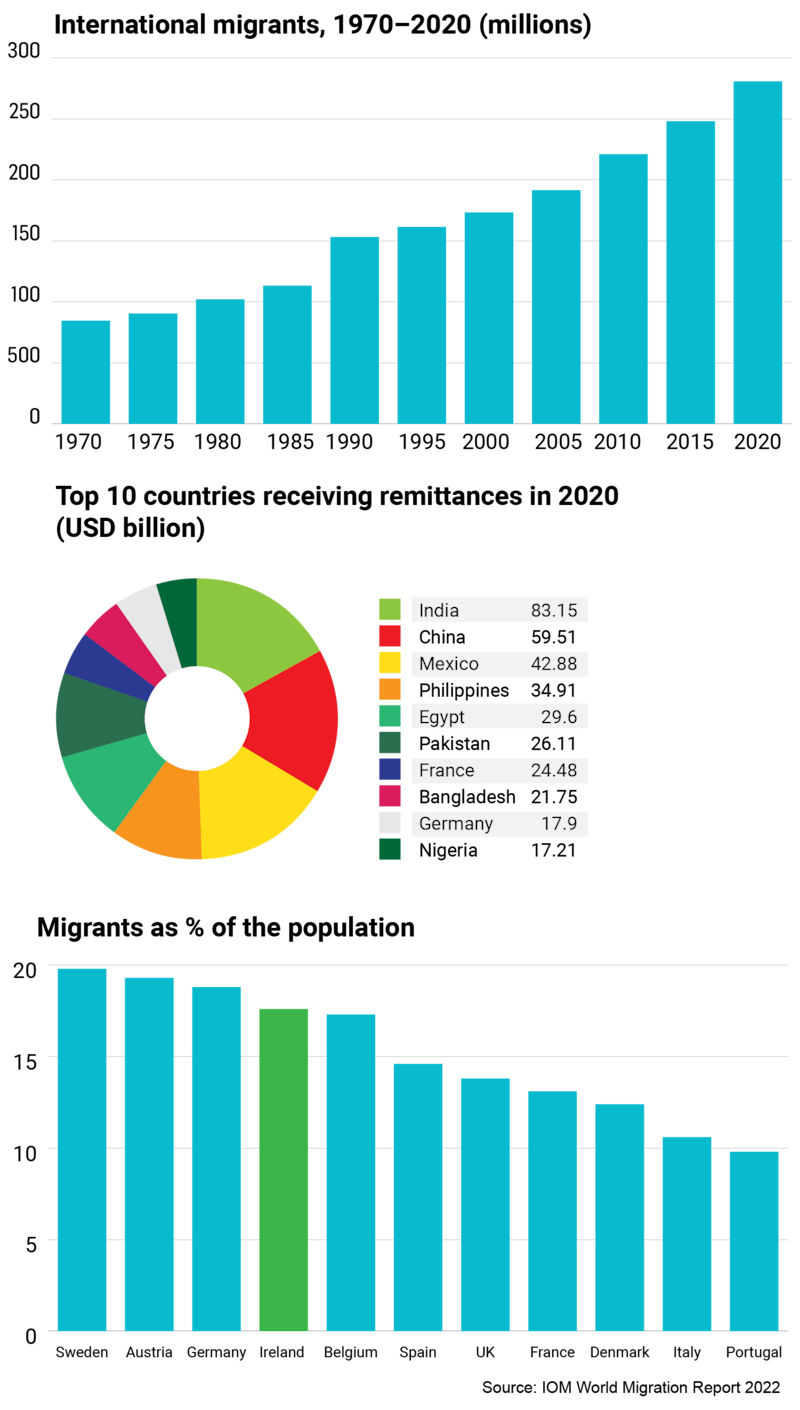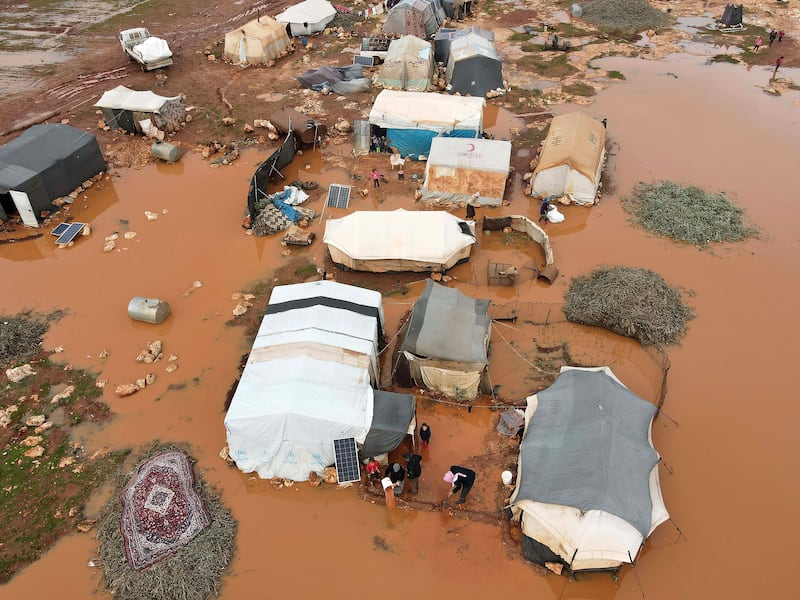In 2020, the latest year estimates were available, 3.6 per cent of the world’s population were living outside the country they were born in – an increase from 3.2 per cent a decade before. That equates to around 281 million people, according to estimates compiled by the International Organisation for Migration (IOM).
The vast majority of that is labour migration, says Martin Ruhs, professor of migration studies at the European University Institute. There are also more than 6 million international students.
In terms of global migration figures, a lot depends on the shifting policies of countries, as well as historical ties, such as people from a country that was historically colonised moving to their former coloniser. “Long-term data shows that international migration is not uniform across the world but is shaped by economic, geographic, demographic and other factors,” says the IOM.
Climate migration is inevitable; it is already under way ... Migration is not a security issue, it’s an economic and humanitarian issue.
— Gaia Vince, author of Nomad Century
In 2020, Europe had around 87 million international migrants, IOM says, up from 46.9 million in 1990, while Asia has 86 million, up from 48.2 million. Some 59 million are in North America, compared to 27.6 million in 1990. In terms of the number in comparison to the actual populations of the regions, Oceania has the highest proportion of international migrants, at 22 per cent of its population; North America has around 16 per cent; and Europe has 12 per cent. This compares to 1.8 per cent in Asia and 1.9 per cent in Africa.
Some countries have vastly more international migrants than others. Nearly 90 per cent of all people living in the United Arab Emirates were migrants in 2021, UN figures show. In Qatar, it was more than 70 per cent; in Australia, more than 30 per cent; and in Switzerland, nearly 29 per cent.
In Ireland, 17.6 per cent of residents are said to be international migrants: less than Germany, Austria and Sweden, but higher than much of the rest of Europe.

“Most of the world’s migration occurs regionally,” say Ruhs. “It would be a mistake to think that labour migration only happens from the very poor countries to very rich countries. I mean, there is also significant labour migration within lower middle-income countries. There are many middle-income countries who are employing migrants from lower-income countries that are in their region. And of course, there’s also labour migration within countries that have relatively similar economic development.”
The vast majority of labour migrants in the world are moving legally, states Ruhs. “There are a significant number who would like to move abroad for employment and cannot do so because of restrictive immigration policies.”

Podcast: In one of the world’s poorest nations, refugees are welcome
The ability of people to move is largely decided by what the IOM calls “the lottery of birth”. “Some nationality groups are much less likely to have access to visas and visa-free arrangements,” noted the organisation in its latest World Migration Report.
“Nationals from countries with very high levels of human development can travel visa-free to around 85 per cent of all other countries worldwide. These countries are also significant and preferred destination countries. However, the visa restrictions in place for countries with very low levels of human development indicate that regular migration pathways are problematic for citizens. Irregular pathways are likely to be the most realistic (if not the only) option open to potential migrants from these countries.”
“If you take Ireland, the majority of people coming here are coming here legally and they’re coming here to work,” said Piaras Mac Éinrí, a migration studies lecturer in UCC.
He says that in the last century, “and particularly in the era of globalisation,” more people are moving country because “transport is cheaper now than it was years ago, and job opportunities arise in a more integrated international labour market.”
“Up to now, labour migration is a function of the demands of the market,” he explains. “Most countries are looking at the moment for people with IT skills and people with medical skills ... And then at the bottom end of the market you have people who are wanted because they will do the work that other people in the receiving country don’t want to do.”
Alongside that, he said, “you see countries like Ireland, deliberately following policies which are based on attracting foreign direct investment and therefore creating jobs. And the last 30 years has been a real shift here, because we’ve moved away from being a country solely of emigration to being a country where there are movements in and out of the country and also return: a lot of Irish immigrants come back.”

The effect of international investment by corporations is to create a kind of “movable feast,” because “as soon as that place becomes more expensive, in terms of labour costs and everything else, the major corporations are quite likely to pick up and move off somewhere else,” says Mac Éinrí.
This can generate a “race to the bottom,” with a “huge level of exploitation in places like Bangladesh and Vietnam,” which has generated “a good deal of instability in people’s internal labour economies and in turn that generates movements out of countries.”
Sending back money
One way to track global migration trends is by looking at remittances – the money that migrants send back to their home countries. Though not everything is captured by them, World Bank figures showed there was an increase in remittances from 109.79 billion euros in 2000 to 642.29 billion euros in 2020.
For most of the past 18 years, the highest recorded remittances have gone to India, with 76.12 billion euros sent back in 2020. That year, the next highest were China (54.44 billion euros), Mexico (39.25 billion), the Philippines (31.93 billion), Egypt (27.08 billion), Pakistan (23.87 billion), France (22.41 billion), Bangladesh (19.94 billion), Germany (16.37 billion) and Nigeria (15.73 billion). This compares to 1995, when five European countries (Germany, France, Portugal, Greece and Spain) were in the top 10 countries receiving remittances. Germany and France have consistently been in the top 10.
The main sources of remittances tend to be high-income countries. The US is at the top, with an outflow of 62.20 billion euros in 2020, followed by the UAE (39.51 billion), Saudi Arabia (31.65 billion), Switzerland (25.57 billion) and Germany (20.12 billion). In 2020, four EU countries (Germany, France, Luxembourg, and the Netherlands), plus Switzerland, were in the top-ten countries from which remittances are sent.
Refugees

Refugees – who are fleeing wars, dictatorships and persecution, and have a right to international protection – make up a small proportion of international migrants. There are 27.1 million refugees in the world and 4.6 million asylum seekers. Of the refugees, 69 per cent came from just five countries: Syria, Venezuela, Afghanistan, South Sudan and Myanmar. The vast majority – 72 per cent – are hosted in neighbouring countries, and 83 per cent of refugees are living in developing countries. The top hosts globally are Turkey, Colombia, Uganda, Pakistan and Germany.
Climate change
In terms of global migration figures going forward, climate change is creating a significant unknown. With each degree that the global temperature rises, one billion more people will either live outside the climate conditions that humanity is used to, or will be forced to migrate, according to a 2020 study. That could affect up to 3 billion people over the next 47 years, the scientists said, depending on scenarios of population growth and warming.
Climate change is already very clearly leading to displacement in countries such as Somalia, where the worst drought in decades displaced more than one million people internally by August last year. Many of the displaced move from rural areas to cities in their own countries. The number of people living in cities globally has increased almost six-fold since 1950.
Around 330,000 people attempted to enter Europe without authorisation in 2022, in a six-year high. Some of those were undoubtedly driven by factors related to climate change, while many others are refugees who have no legal way to enter European territory, but once there can make a claim for international protection.

Many analysts are hesitant to say what will happen in years to come, or readily admit that they do not know. A debate around the idea of climate refugees is not new though.
In 1985, Essam El-Hinnawi, the executive director of the UN Environment Programme first wrote about “environmental refugees.”
“The vulnerable are the poor,” he wrote. They “crowd flood-prone river valleys”, “live in slums precariously perched on city hillsides” and “abandon arid land when their cattle have grazed the last bit of grass”.
Developing solutions would require the international community to recognise the problem, he warned, but analysts today still say not enough has been done.
“Climate migration is inevitable; it is already under way,” says Gaia Vince, the author of Nomad Century, which suggests ways to manage climate change-related migration. “We must adapt our border policies to this changed global landscape, rather than burying our heads in the sand. That means talking openly about how we can best manage people movement for the benefit of all of our communities and societies ... Migration is not a security issue, it’s an economic and humanitarian issue.”
“It baffles me that this isn’t really on the horizon yet,” said Mac Éinrí. “It simply hasn’t been addressed, in part because there’s no legal framework within which to address this. You can’t apply for refugee status simply because your country has become uninhabitable.”
“What I would say is that in the meantime, what you’re actually seeing is a lot of measures being taken by states in the global north, in effect to securitise their borders.” Increased securitisation at borders is the most “likely scenario,” he says.
And in that case, where are those people going to go? “I don’t know,” Mac Éinrí replies.



















